Ever painted a wall and wondered why the color looks different when dry? Discover the mystique behind the transformation of paint colors as they dry!
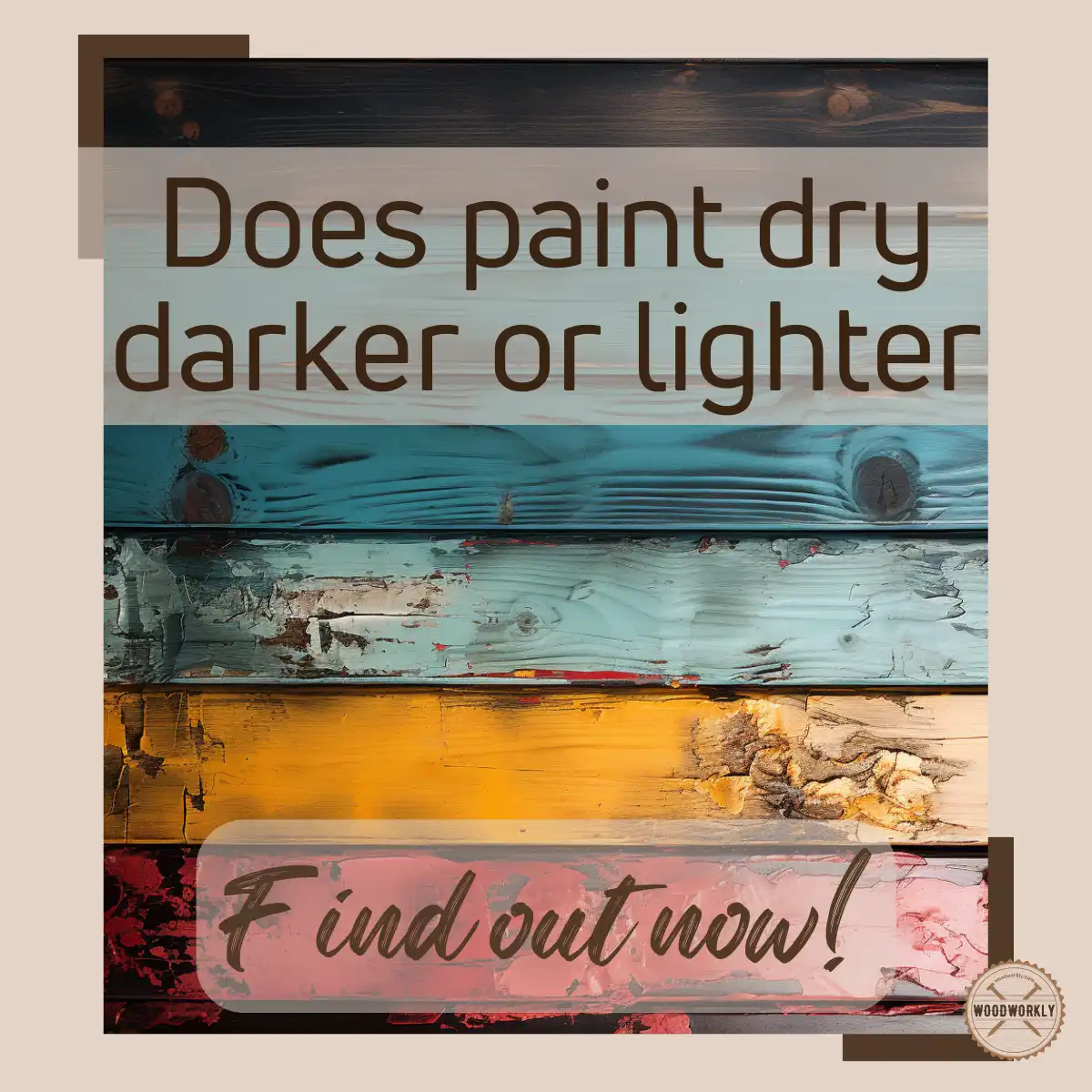
Did you know that the process of painting a space involves more than just picking a color from a swatch?
In my woodworking history, a curious question that homeowners and artists often ask is, ‘Does paint change colors upon drying?’
So, I thought to conduct research with the help of paint experts to find out how paints behave when they are drying, especially their color change.
I was able to find lots of useful info and thought to share it with you too.
So let’s discuss, Does paint dry darker or lighter?
Paint can dry either darker or lighter, depending on the type and finish. Acrylic, latex, and oil paints tend to dry darker, while chalk and watercolor paints typically dry lighter. Factors like lighting, surface, and surroundings also influence the apparent color of dried paint.
Now don’t think that you are fully aware of this, there are many other things that you need to know about the painting process.

In this article, I’m going to take a look at paint drying dynamics, why and how different types of paint exhibit variations in darkness or lightness.
I believe that by the end of this article you will be able to navigate the painting process with more precision and find out does paint dry darker or lighter with the reason.
Let’s jump in!

Does Paint Dry Darker or Lighter?
Paint is usually slightly darker in color when dry than when wet.
This is because the reflectivity of wet paint is high and when it dries, the solvent evaporates and the paint film becomes less reflective.
As a result, the color appears to be deeper or darker.
Did you know that the degree of darkening can vary depending on the type and brand of paint used, the color pigments used and the specific conditions during the drying process?
Some colors may show more significant differences than others.

Which Paints Dry Darker?
Different types of paint can have different behavior when drying and changing color.
I have prepared a list of paints dry darer for you below.
- Water-based paint: Latex paint
- Oil-based paint: Alkyd paint
- Acrylic paint: Enamel paint
Now I will tell you about the above paints dry darker and how to dry them dark based on my experience.
Water-Based Paint
Latex Paint
Water-based paint, often called latex paint. These are latex paints used for larger projects such as repainting the walls of a room, doors and trim.

Now let’s look at its special features.
- Composition – In latex paints, water is used as a carrier for the pigment particles and the binder that holds them together.
- Drying Process – This is where the paint usually dries as the water evaporates. Color may lighten when wet due to water content.
- Color Change – Water-based paints tend to dry to a slightly darker color as the water evaporates and the pigment settles in the binding medium.
Oil-Based Paint
Because oil-based paints usually take a long time to dry, they are only used on canvas for paintings and photographs.
Now let’s look at its special features.
- Composition – Oil-based paints, using mineral spirits or other solvents as carriers for pigments. The binder is usually oil such as linseed oil.
- Drying Process – The solvent evaporates, leaving the oil and pigment to form a thick, durable coating.
- Color change – Oil-based paints can darken when dry, but the difference is more noticeable compared to water-based paints. Oils in paint can affect how light is reflected.
Alkyd Paint
Alkyd paint is a type of synthetic resin paint that is often used as an oil-based or substitute for traditional oil paint.
Alkyd resins are synthetic resins modified with oil.

These paints combine the durability and smoothness of oil-based paints with the relatively fast drying time of acrylic paints.
Now let’s look at its special features.
- Composition – An oil-based paint with alkyd resin as a binder.
- Drying Process – Similar to oil-based paints, the solvent evaporates and the alkyd resin forms a hard film.
- Color Change – Alkyd paints can darken as they dry, and the particular alkyd resin used can affect the extent of this color change.
Acrylic Paint
You can buy acrylic paint in the market in different colors like yellow, red, blue, green, purple, orange and brown.
Such paints can be used for fabric, wood, metal, ceramics and fabric.

Acrylic paint will be darker than the color you see when you start painting, but it will be the same color as the paint test.
Now let’s look at its special features.
- Composition – Acrylic paints use water as a carrier, but they have an acrylic polymer emulsion as a binder.
- Drying Process – As the water evaporates, the acrylic polymer particles bond together to form a thick, flexible film.
- Color Shift – Acrylic paint may show minimal color shift when drying. They often dry very close to the wet color, but some pigments may still undergo subtle changes.
Enamel Paint
Enamel paint is a type of paint known for its hard, glossy finish when dry.
It can be used on a variety of surfaces and is available in both oil-based and water-based formulations.

Here are some key characteristics and features of enamel paint.
- Composition – Enamel paints can be oil-based or water-based and often contain a glossy or semi-glossy finish.
- Drying Process – The solvent or water evaporates leaving a hard, smooth surface.
- Color Change – The drying characteristics of enamel paints depend on their base. Enamel paint may show some darkening, but this may be influenced by the particular composition.
Keep in mind that the quality and exact composition of your paint can vary between manufacturers.
I always advise you to check the product information provided by the paint manufacturer for specific information on color changes during drying.
Paints Dry Lighter
Different paints exhibit different drying behavior and some paints will dry more easily than their wet appearance.

In my experience, here are the paints that dry lighter,
- Water-Based Paint – Latex Paint
- Acrylic Paint
- Watercolor Paint
- Tempera Paint
- Gouache Paint
Now let’s explore paints dry lighter and their features.
1. Water Based Paint – Latex Paint
Water-based paint, commonly known as latex paint, is a type of paint that uses water as a carrier or solvent for pigments and binders.
This paint has become popular for its ease of use, low toxicity and environmental friendliness.
Here are the main characteristics of water-based paints.
- Composition – Water is used as the primary carrier for pigments and binders.
- Drying Process – During the drying process the water evaporates, forming a thick coating of pigments and binders.
- Color Change – Water-based paints usually dry close to their wet color and in some cases, they can appear slightly lighter as the water content evaporates.
2. Acrylic Paint
Acrylic paint is a popular type of paint that uses acrylic polymer emulsion as a binder.
These paints are known for their versatility, quick drying time, and ability to create vibrant and lasting artwork.
Here are the main characteristics of acrylic paint.
- Composition – Acrylic paint uses water as carrier and acrylic polymer emulsion as binder.
- Drying Process – As the water evaporates, the acrylic polymer particles bond together to form a thick, flexible film.
- Color Shift – Acrylic paints are known for minimal color shift during drying. In most cases, they dry very close to the wet color, and the change is often subtle.
3. Watercolor Paint
Watercolor paint is a type of paint that uses water-soluble pigments to create vibrant and translucent works of art.
It is a popular medium among artists because of its versatility and unique characteristics.
Here are the main features of watercolor paints.
- Composition – Watercolor paints are pigments, often gum arabic, suspended in a water-soluble solution.
- Drying Process – Watercolor pigments penetrate the paper fibers and the water evaporates leaving the color behind.
- Color Change – Watercolor paintings can lighten as the water evaporates, and the pigment settles into the paper. This effect can be influenced by factors such as paper absorption.
4. Tempera Paint
Tempera paint is a type of water-based paint that has been used for centuries. It is known for its quick drying time, matte finish and versatility.
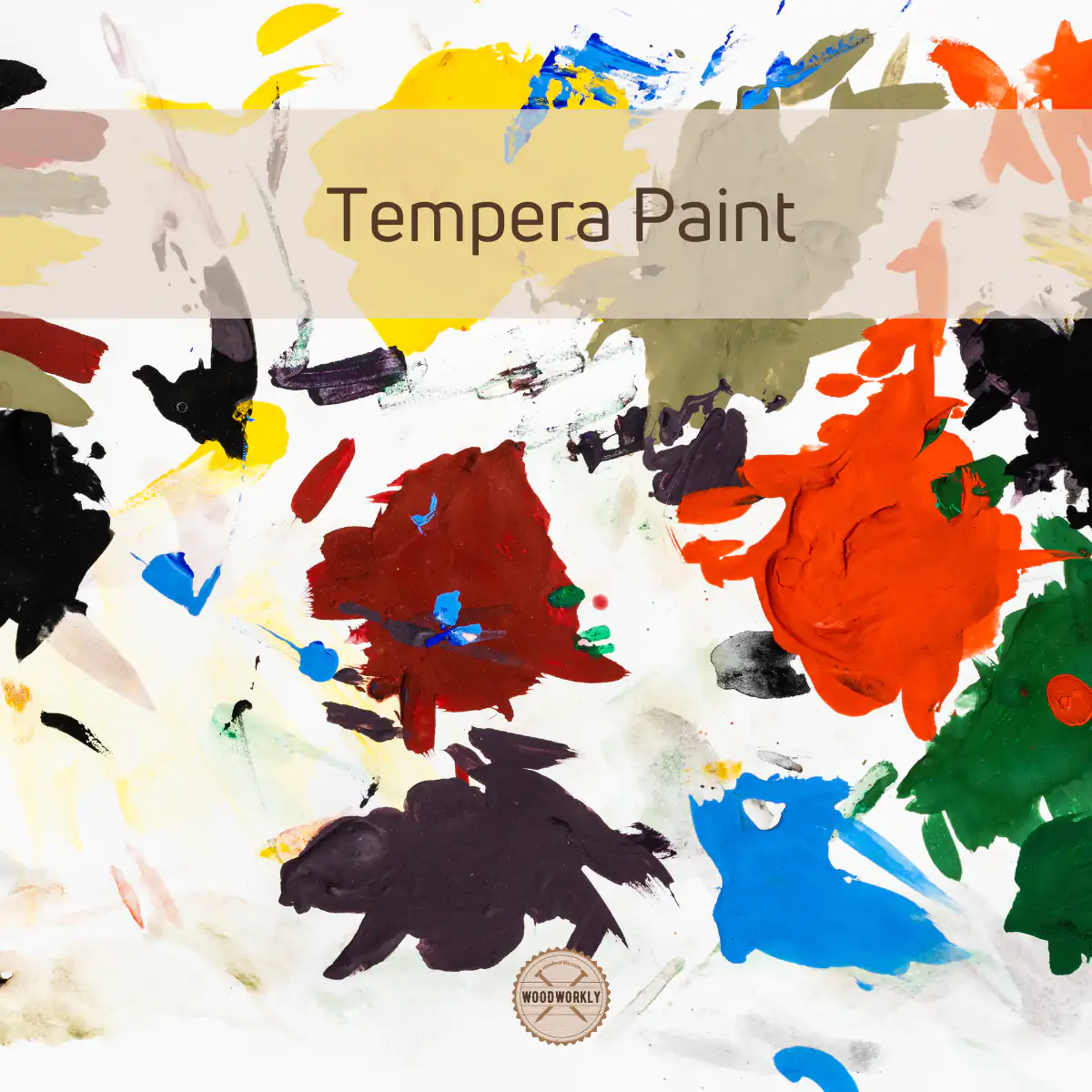
Historically, tempera was a popular medium for painting on a variety of surfaces, including wood, canvas, and parchment.
Here are some key characteristics and features of tempera paint.
- Composition – Tempera paint uses pigments mixed with a water-soluble binder, often egg yolk.
- Drying Process – The water in the binder evaporates, binding the pigment to the surface.
- Color Distortion – Tempera paint can become slightly lighter due to water evaporation, and the binding of egg yolk can contribute to a matte finish.
5. Gouache Paint
Gouache paint is a water-based paint similar to watercolor, but with a few key differences. It is known for its vibrant colors, opacity and versatility.

Gouache is a popular choice among artists for a variety of applications including illustration, design and fine art.
Here are some key characteristics and features of gouache paint.
- Composition – Similar to gouache watercolors but with a higher pigment concentration and includes a white pigment (such as chalk) for opacity.
- Drying Process – As the water evaporates the gouache dries, and the pigment settles.
- Color Change – Gouache can be light, especially if it contains significant amounts of water, but the amount of lightning can vary.
Keep in mind that the specific behavior of each type of paint can be influenced by factors such as the pigment used, the specific formulation, and drying conditions.
To accurately predict the final color, I recommend that you test a small area before painting a large surface.
Why Does Paint Dry Lighter?
There are several factors that can contribute to the lighter paint drying process than you expected.

Generally paint dries lighter due to the improper mixing of paint, lighting condition, porosity of the painted surface and paint drying temperature level.
let’s talk about them in detail.
1. Improper Mixing Of Paint
Did you know that one common cause is improper mixing of paint?
When different paint colors and ingredients are not sufficiently mixed, the final color may not match the desired swatch color.
To solve this, it is very important to stir the paint thoroughly before starting the painting process.
Proper mixing ensures an even distribution of pigments and other components and you can see a more accurate representation of the selected color as a result.
2. Lighting Condition
Generally, the lighting conditions in the room play a significant role in how paint colors look.
Did you know that the type of light can affect the perceived color as the interaction between light and color is complex?
For example, if the room is lit with light bulbs that emit an orange hue, the paint color may appear warm.
On the other hand, light with a blue or white tint can create cool tones. It is essential to take care of the lighting environment to achieve the desired color result.
3. Porosity of the Painted Surface
Although you may not be aware of it, another factor that can cause paint to dry lightly is the porosity of the painted surface.
If the material is porous, it acts like a sponge and absorbs the paint, affecting your final look.
I recommend you apply additional coats to porous surfaces to compensate for paint shop absorption.
And to avoid this problem, it is recommended to use a primer on porous areas before painting.
4. Drying Temperature
Temperature during the drying process is a less common but potentially contributing factor to color changes.
The drying temperature of the paint can affect its final color.
I assure you that understanding these factors and taking appropriate precautions can contribute to achieving the desired paint color and finish.

Factors that Affect the Color of Paint
As discussed above, the color of paint can be influenced by many different factors, and it is very important for you to understand these factors in order to achieve the desired results in any painting project.
And several key factors contribute to how paint colors appear, from the initial mix of the paint to the conditions during application and drying.
Below I have listed the main factors that affect the color of paint as it dries.
- Mixing the Paint
- Lighting Conditions
- Surroundings
- Porosity in Surfaces
- UV Rays
- Temperature during Application
- Finish
- Paint Type
Here, I have explored each of the above mentioned factors in detail and brought you more details about them.
1. Mixing the Paint
As you know, the way paint is mixed is a primary factor in determining its final color.
If the paint is not thoroughly mixed, the pigment and other components will not be distributed evenly, and color discrepancies will occur between the desired switch and the paint surface.
- Explanation – Proper mixing means stirring the paint thoroughly to ensure even dispersion of pigments and binders. Inadequate mixing can cause color variation, and to solve this, it is essential to stir the paint vigorously before starting application.
2. Lighting Conditions
Light plays a significant role in the perception of paint colors.
The type of light source, its color temperature and the intensity of light in a room can affect the appearance of paint colors.
- Explanation – Different light sources, such as natural sunlight, incandescent bulbs, or LED lights, emit different color temperatures. Warm or cool lighting can cause paint colors to appear different.
It is very important to consider the lighting environment in order to achieve the desired color result.
3. Surroundings
The immediate environment surrounding the paint surface can have a major impact on how the dried paint color is perceived.
- Explanation – A wall freshly painted in light colors can look a bit dull when surrounded by dark walls. This phenomenon can also be observed in works of art whose appearance varies depending on where they are displayed.
The colors of surrounding objects and furniture can reflect on the paint surface and change its appearance and this effect is scientifically known as “Metamerism”.
4. Porosity in Surfaces
Another important factor is the porosity of the painted surface and how much paint it will absorb.
- Explanation – Porous surfaces, such as untreated wood or certain types of drywall, can absorb more paint, affecting the final color.
I would recommend you apply a primer before painting to address porosity issues, especially on surfaces that tend to absorb paint unevenly.
5. UV Rays
Did you know that exposure to ultraviolet (UV) rays from sunlight can affect the lightness or darkness of painted surfaces?
- Explanation – Darker inks, being more pigmented, are often more sensitive to UV exposure and can fade over time, making colors appear lighter. In contrast, lighter colors are less receptive to UV exposure and may retain their original color or appear darker as they cure.
6. Temperature during Application
The temperature when applying paint can affect how it dries and, therefore, its final color. High temperatures can alter the drying process and affect the appearance of the paint.
- Explanation – The optimum temperature for painting is usually above 50 degrees Fahrenheit. Applying paint in conditions within this temperature range ensures proper drying and helps maintain color consistency. I advise you to touch up the paint in the same conditions as the initial application.
7. Finish
Furthermore, the finish of the paint can also affect how the dried paint is perceived.
- Explanation – Matte finish is non-reflective and makes the paint look lighter while glossy finish reflects light. Therefore, I would advise you to pay special attention to the choice of finish as it affects the overall aesthetics of a painted surface.
8. Paint Type
Another important factor is that different types of paint have different effects on color when they dry.
- Explanation – For example, many paints with a glossy finish, such as acrylic, oil and latex paints, tend to dry dark. In contrast, paints with a matte finish such as chalk paint, some interior paints, and exterior paints may lighten after drying.
Effect of Sheen Type on the Perception of Paint Color
| Type of Paint | Type of Sheen | Effect on Perceived Color |
| Water-based (Latex) | Flat (Matte) | Paint may appear lighter |
| Eggshells | Slight sheen, moderate effect on color | |
| Satin | Slight sheen, minimal color alteration | |
| Semi-Gloss | Noticeable sheen, color may appear darker | |
| High-Gloss | Highly reflective, can darken color | |
| Oil-Based (Alkyd) | Flat (Matte) | Matte finish, tends to make color lighter |
| Eggshells | Slight sheen, moderate effect on color | |
| Satin | Subtle sheen, minimal color alteration | |
| Semi-Gloss | Noticeable sheen, color may appear darker | |
| High-Gloss | Extremely reflective, can significantly darken color | |
| Acrylic | Matte | Non-reflective, paint color may appear lighter |
| Satin | Slight sheen, minimal color alteration | |
| Glossy | Reflective, can darken the perceived color | |
| Enamel (Oil or Water) | Matte | Matte finish, tends to make color lighter |
| Satin | Subtle sheen, minimal color alteration. | |
| Glossy | Reflective, can darken the perceived color |
Keep in mind that everything from the initial mixing process to the conditions during application and drying are important in determining the final appearance of the painted surface.
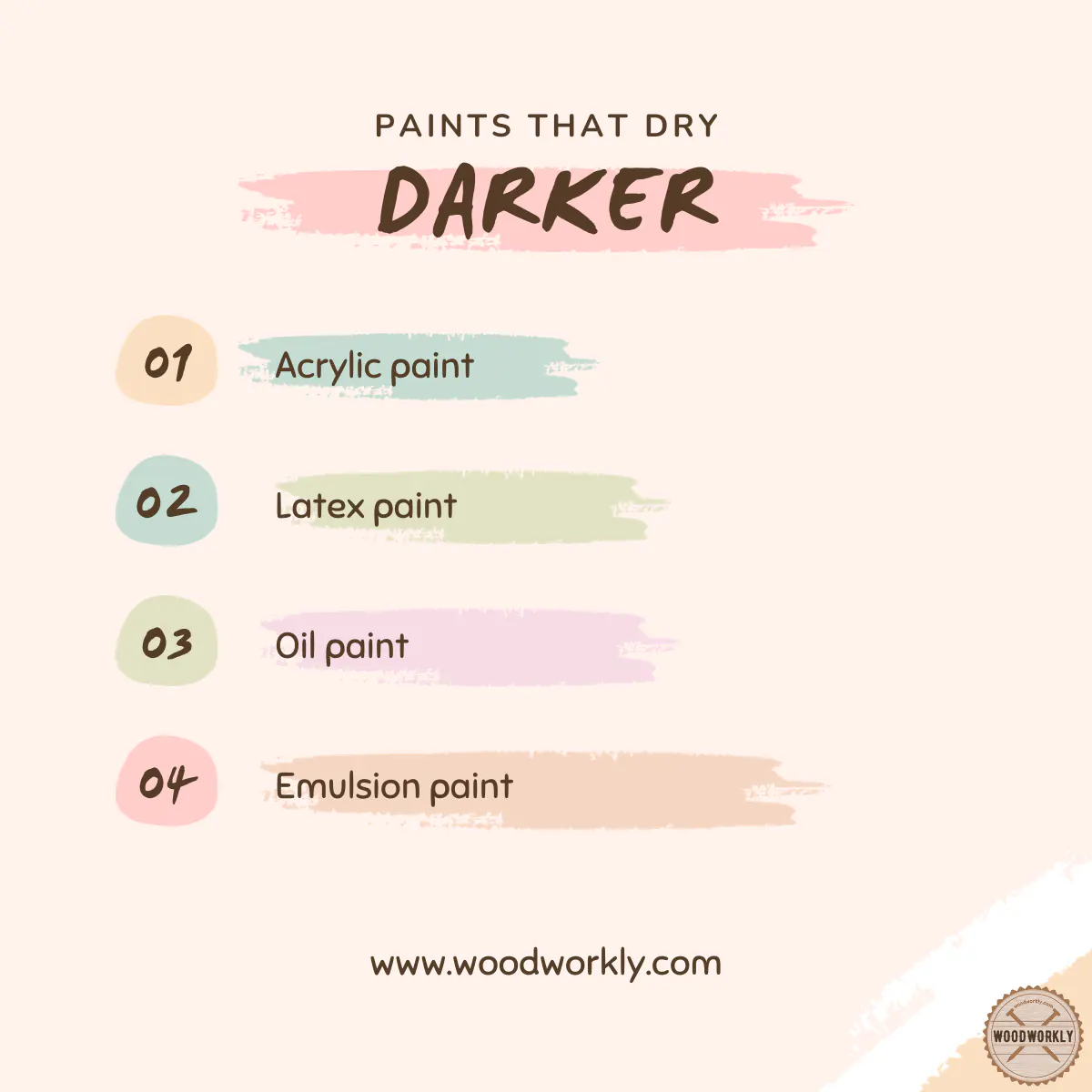
How Long Does Paint Take to Dry?
Paint drying time can vary significantly depending on a variety of factors, including the type of paint, environmental conditions, and the thickness of the coat applied.
Here is a general overview of the paint drying times I explored,
Water-Based Paint (Latex or Acrylic)
Did you know that water-based paints usually dry faster than oil-based paints?
Generally, under optimal conditions, water-based paint dry and can be touched within 1-2 hours. However, I strongly remind you to wait at least 4 hours before applying a second layer.
It may take days or weeks for full curing, during which time the paint will be more rigid and durable.
Oil-Based Paint
Oil-based paints have a longer drying time compared to water-based paints. Oil-based paint can take 6 to 8 hours to dry to the touch and be ready for a second coat.
Full curing can take days to weeks as the paint hardens over time.
Enamel Paint
Enamel paints, whether oil-based or water-based, have a longer drying time due to their glossy finish.
Enamel paint drying time can range from 8 to 24 hours and complete healing may take several days.
I advise you to always refer to the specific product guidelines for correct drying times based on the type and brand of paint used.
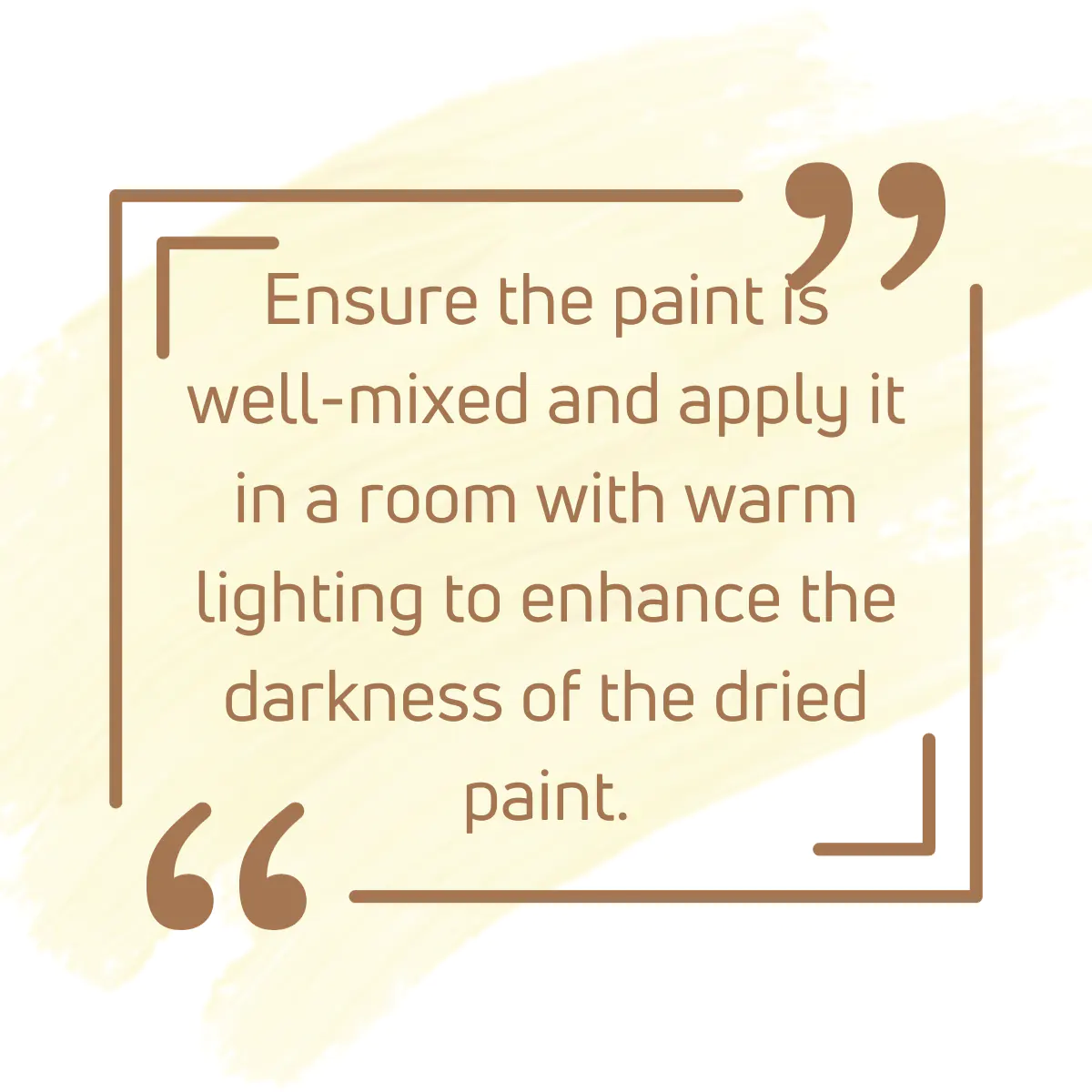
How to Avoid Darker or Lighter Paint?
There are a few things you should follow to get the desired paint color without unexpected darkening or fading.
So, I will now give you some tips that will help you avoid unwanted changes in paint color.
1. Mix the Paint Properly before Applying
Did you know that the wrong mix can always lead to uneven pigment distribution?
It causes color variations and vigorous stirring of the paint is essential for uniformity and accurate representation of the desired color.
2. Choose High Quality Paint from Reputable Manufacturers
I strongly remind you here that quality paints often have better compounds, which contribute to color stability.
Don’t forget to choose paints with well formulated pigments and binders if you want more predictable and consistent results.
3. Test Paint Colors on Small Samples before Applying to the Entire Surface
This allows you to observe how paint color interacts with light and specific surfaces.
If you want to avoid surprises I would advise you to definitely test paint colors in a small amount beforehand to apply to the entire surface.
4. Ensuring Consistent Lighting Conditions during the Painting Process
Did you know that changes in lighting can significantly affect how colors appear?
If you want to accurately assess paint color and avoid discrepancies caused by variations in natural or artificial light, be sure to maintain consistent lighting in your work area.
5. Use Lighting that Closely Matches the Environment of the Painted Surface
When you match the colors, you should make good use of the lighting conditions in the desired location.
This will greatly help you ensure that the color you see during application is the color you see in the final setting.
6. Properly Prepare the Painting Surface Including Priming
Porous surfaces can absorb paint differently, affecting the final color.
You can create an even base by using a primer here, reducing the risk of uneven absorption and color transfer.
7. Paint under Suitable Environmental Conditions
I advise you to follow the recommended temperature guidelines for painting.
Keep in mind that high temperatures can affect how the paint dries and can cause unexpected color changes.
And ideal painting conditions are usually above 50 degrees Fahrenheit (10 degrees Celsius).
8. Paint Continuously Over all Coats
Here you maintain a consistent application method, thickness and drying time for each coat. This will definitely help you to get a uniform color throughout the painting process.
9. Use Neutral or Daylight Lighting
Here I can introduce you to color casts to tinted lighting.
Tinted lighting has a huge impact on how paint colors are perceived. You can minimize this risk by using neutral or daylight lighting.
10. Allow Adequate Drying and Curing Time between Coats
Did you know that rushing the drying and curing process can cause discoloration?
You can avoid dark or light paint by following the recommended drying times between coats and allowing enough time for the paint to fully cure.
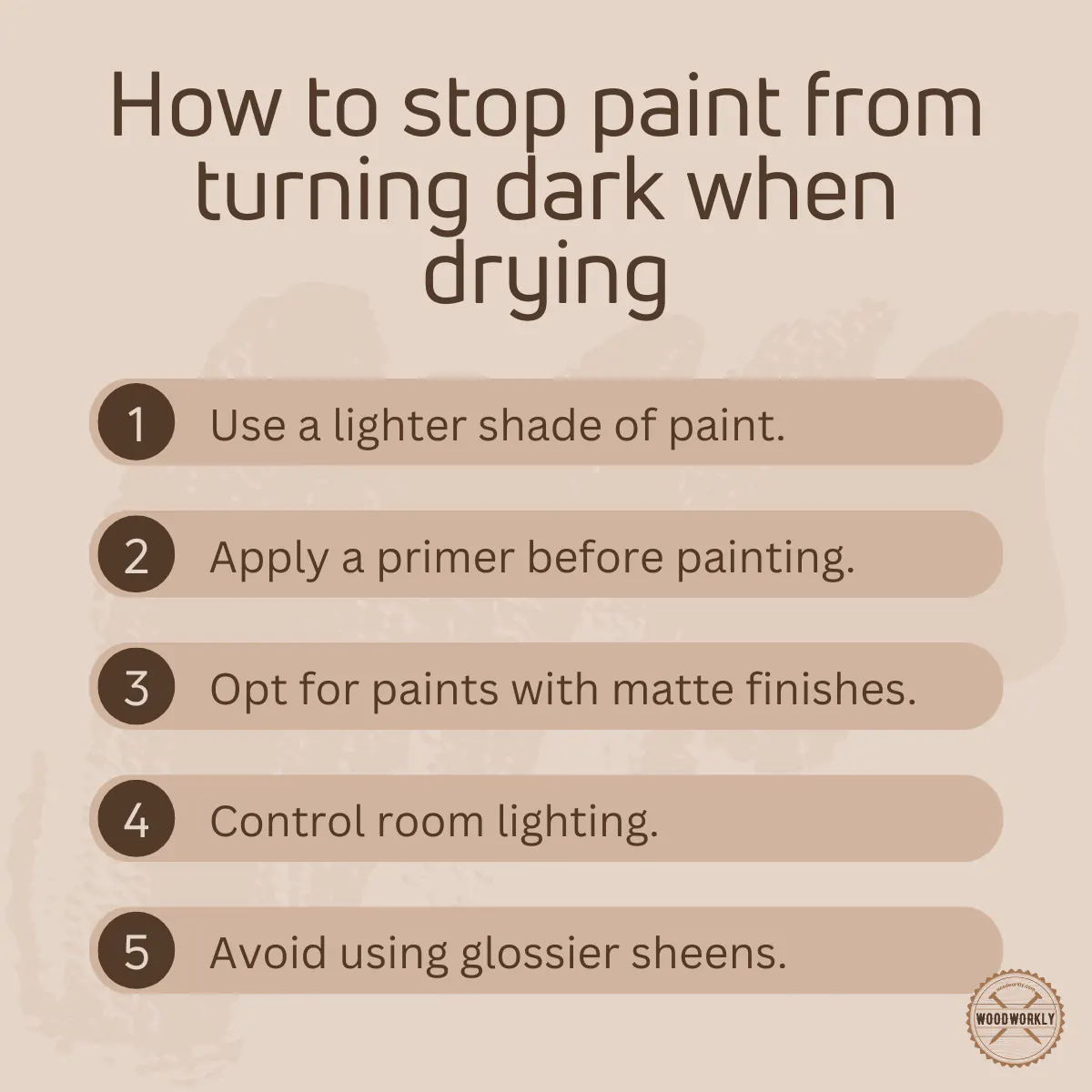
Can Surrounding Objects Affect the Paint Color?
Yes, surrounding objects can significantly affect the color that appears on the paint surface.
You should be aware that the interaction between the color of the painted area and the colors of nearby objects creates a visual context that can change the overall perception of paint color.
Here’s what I found out about how surrounding objects affect paint color.
Reflective Effect
Surrounding objects, especially those with reflective surfaces, can scatter light onto the paint surface.
This reflected light carries the color of surrounding objects and affects the way the painted area looks.
For example, a wall painted in a light color can appear quite dark if it is next to a dark-colored, reflective surface.
Metamerism
As I mentioned above, Metamerism is a phenomenon in which colors appear differently under different lighting conditions.
This can contribute to the metamorphosis of surrounding objects, such as furniture, artwork, or the color of adjacent walls.
You should know that the colors of these objects can interact with the light in the space and affect how the painted surface is perceived.
Contrast and Perception
The contrast between the painted surface and surrounding objects can influence the perceived color.
A color that looks great in isolation may look different when placed next to contrasting colors.
For example, a wall painted in a light color can look dark when surrounded by dark-colored furniture or decorations.
Natural and Artificial Light
Both the surrounding natural and artificial light sources play a crucial role.
Natural light from windows or doors can introduce different tones throughout the day.
Meanwhile, artificial light, whether warm or cool in temperature, can produce different colors on painted surfaces.
The color of surrounding objects can interact with these light sources, causing changes in perceived paint color.
Optical Illusions
Surrounding objects can create optical illusions that affect how we perceive color.
For example, the colors of adjacent walls or furniture can create a contrast that makes the paint color appear warmer or cooler than it actually is.
Remember that these perceptual effects contribute to the overall visual effect of the painted space.
Tips for Managing Impact
When choosing paint colors, it is essential to consider the colors of the surrounding objects and the lighting conditions of the space.
Testing paint samples in real environments helps anticipate how the color will interact with the surroundings.
It is important to consider the overall color scheme and how the various elements complement each other, as striking a balance between the colors of the painted surface and surrounding objects can create a harmonious and visually appealing space.
Congrats folks! Now you know the crystal clear answer for the burning question you had about, does paint dry darker or lighter in detail with lots of factors.
So, let’s answer soem frequently asked questions.
FAQs
Does acrylic paint dry darker or lighter?
Acrylic paint typically dries darker due to the evaporation of water content, causing the pigments to become more concentrated. However, the degree of darkness can vary depending on the brand and quality of the paint.
How does the finish affect the dried paint color?
Paint finishes like gloss and semi-gloss tend to make the paint appear darker as they reflect more light, while matte and flat finishes often result in a lighter appearance due to their light-absorbing qualities.
How does lighting influence the dried paint color?
The type of lighting, such as natural, incandescent, or LED, can affect the perception of the paint’s color, with certain lighting conditions making the paint appear either lighter or darker.
Does the number of paint coats affect the final color?
Multiple coats don’t necessarily darken the paint but can deepen and even out the color, ensuring consistent coverage and richness in tone.
How does the surrounding environment affect the dried paint color?
The color of the surrounding walls and furniture can influence the perception of the paint’s color, with lighter surroundings making the paint appear darker and vice versa due to the phenomenon of metamerism.
Does exterior paint dry darker or lighter?
Exterior paint tends to dry lighter over time, particularly due to exposure to natural light and weathering elements that can cause the paint to fade.
How can I ensure the dried paint matches the swatch color?
To achieve a color match, ensure the paint is well-mixed, use higher-quality paint, and consider the lighting and surroundings where the paint will be applied. Always test a small area and allow it to dry before proceeding with the full application.
Will the paint color change over time?
Paint, especially when exposed to UV rays, can fade and appear lighter over time, but this process takes several years and is more pronounced in darker pigments.
Do certain colors of paint dry differently?
Yes, colors with different undertones and pigments can dry either lighter or darker, and the effect can be influenced by the type and quality of the paint.
How does the type of surface affect the dried paint color?
The surface type can influence the dried paint color; for instance, porous surfaces like wood can make the paint appear lighter, while non-porous surfaces may result in a darker appearance.
Did I cover all you wanted to know about: Does Paint Dry Darker Or Lighter
In this article, I’ve deeply discussed does paint dry darker or lighter considering different types of paints, and deeply explored the factors that affect paint color and how to avoid color change of paint including expert tips.
Most paints, including acrylic, latex, and oil, tend to dry darker as water or solvents evaporate, and pigments become more concentrated. However, factors like paint finish, lighting, and surroundings can influence whether paint appears lighter or darker once dry.
Furthermore, I’ve answered soem frequently asked questions as well.
Hope you’ve learned all you wanted to know about does paint dry darker or lighter based on my experience and according to the info I gathered from interview sessions held with the paint experts.
Now it’s time to understand how your paint color changes with time based on the condition it faces. Do the necessary steps to keep your paint as it was. Happy wood finishing!